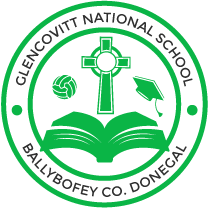CRITICAL INCIDENT MANAGEMENT POLICY
The key to managing a critical incident is planning. Glencovitt N.S. has developed a Critical Incident Management Plan, outlining who will do what in the event of a tragedy.
Glencovitt N.S. aims to protect the well-being of its students and staff by providing a safe and nurturing environment at all times. The Board of Management, through Martina Mallon Principal has drawn up a Critical Incident Management Plan as one element of the school’s policies and plans.
Review and Research
The Critical Incident Management Team( CIMT) have consulted resource documents available to schools on www.education.ie and www.nosp.ie including:
- Responding to Critical Incidents Guidelines and Resources for Schools (NEPS 201 6)
- Suicide Prevention in Schools: Best Practice Guidelines (IAS, National Suicide Review Group (2002)
- Suicide Prevention in the Community – A Practical Guide (HSE 2011)
- Well-Being in Post-Primary Schools Guidelines for Mental Health Promotion and Suicide Prevention (DES, DOH, HSE 2013)
- Well-Being in Primary Schools – Guidelines for Mental Health Promotion
(DES, DOH, HSE 201 5)
Definition of “Critical Incident”
The staff and management of Glencovitt N.S. recognise a critical incident to be “an incident or sequence of events that overwhelms the normal coping mechanism of the school”. Critical incidents may involve one or more students or staff members, or members of our local community. Types of incidents might include
- The death of a member of the school community through accident, violence, suicide or suspected suicide or other unexpected death
- An intrusion into the school
- An accident involving members of the school community
- An accident/tragedy in the wider community
- Serious damage to the school building through fire, flood, vandalism, etc
- The disappearance of a member of the school community
Aim
The aim of the CIMP is to help school management and staff to react quickly and effectively in the event of an incident, to enable us to maintain a sense of control and to ensure that appropriate support is offered to students and staff. Having a good plan should also help ensure that the effects on the students and staff will be limited. It should enable us to effect a return to normality as soon as possible.
Creation of a coping supportive and caring ethos in the school
We have put systems in place to help to build resilience in both staff and students, thus preparing them to cope with a range of life events. These include measures to address both the physical and psychological safety of the school community.
Physical safety
- Evacuation plan formulated
- Regular fire drills occur
- Fire exits and extinguishers are regularly checked
- Child Safe Guarding Statement and Assessment of Risk
- Code of Behaviour
- Anti-Bullying Policy
- Rules of behaviour for each class
- Front door locked during class time
Psychological safety
The management and staff of Glencovitt National School aim to use available programmes and resources to address the personal and social development of students, to enhance a sense of safety and security in the school and to provide opportunities for reflection and discussion.
- Social, Personal and Health Education (SPHE) is integrated into the work of the school. It is addressed in the curriculum by addressing issues such as grief and loss; communication skills; stress and anger management; resilience; conflict management; problem solving; help-seeking; bullying; decision making and prevention of alcohol and drug misuse. Promotion of mental health is an integral part of this provision
- Staff have access to training for their role in SPHE
- Staff are familiar with the 2017 document on Procedures for Primary and Post Primary schools and details of how to proceed with suspicions or disclosures
- Books and resources on difficulties affecting the primary/post primary school student are available
- Information is provided on mental health in general and such specific areas as signs and symptoms of depression and anxiety
- The school has developed links with a range of external agencies – list these agencies
- N.E.P.S
- Gardaí
- Tusla
- Inputs to students by external providers are carefully considered in the light of criteria about student safety, the appropriateness of the content, and the expertise of the providers. See DES Circulars 0022/2010 (Primary)
- The school has a clear policy on bullying and deals with bullying in accordance with this policy
- There is a care system in place in the school using the “Continuum of Support” approach which is outlined in the NEPS documents published on 2007 for primary schools.
- Students who are identified as being at risk are referred to their class teacher, concerns are explored and the appropriate level of assistance and support is provided. Parents are informed, and where appropriate, a referral is made to an appropriate agency.
- Staff are informed about how to access support for themselves.
Critical Incident Management Team (CIMT)
A CIMT has been established in line with best practice. The members of the team were selected on a voluntary basis and will retain their roles for at least one school year. The members of the team will meet annually to review and update the policy and plan. Each member of the team has a dedicated critical incident folder. This contains a copy of the policy and plan and materials particular to their role, to be used in the event of an incident.
Team leader: Martina Mallon
Role
- Alerts the team members to the crisis and convenes a meeting
- Coordinates the tasks of the team
- Liaises with the Board of Management; DES; NEPS;
- Liaises with the bereaved family if warranted
Garda liaison Martina Mallon
Role
- Liaises with the Gardaí
- Ensures that information about deaths or other developments is checked out for accuracy before being shared
Staff liaison Kathleen Kelly McIntyre
Role
- Leads briefing meetings for staff on the facts as known, gives staff members an opportunity to express their feelings and ask questions, outlines the routine for the day
- Advises staff on the procedures for identification of vulnerable students
- Provides materials for staff (from their critical incident folder)
- Keeps staff updated as the day progresses
- Is alert to vulnerable staff members and makes contact with them individually
- Advises them of the availability of the EAS Counselling Service and gives them the contact number.
Student liaison Kathleen Kelly McIntyre
Role
- Alerts other staff to vulnerable students (appropriately)
- Provides materials for students (from their critical incident folder)
- Maintains student contact records (R1).
- Looks after setting up and supervision of ‘quiet’ room where agreed
Community/agency liaison Geraldine McGuinness
Role
- Maintains up to date lists of contact numbers of
- Key parents, such as members of the Parents Council
- Emergency support services and other external contacts and resources
- Liaises with agencies in the community for support and onward referral
- Is alert to the need to check credentials of individuals offering support
- Coordinates the involvement of these agencies
- Reminds agency staff to wear name badges
- Updates team members on the involvement of external agencies
Parent liaison Martina Mallon
Role
- Visits the bereaved family with the team leader
- Arranges parent meetings, if held
- May facilitate such meetings, and manage ‘questions and answers’
- Manages the ‘consent’ issues in accordance with agreed school policy
- Ensures that sample letters are typed up, on the school’s system and ready for adaptation
- Sets up room for meetings with parents
- Maintains a record of parents seen
- Meets with individual parents
- Provides appropriate materials for parents (from their critical incident folder)
Media liaison Martina Mallon
Role
- In advance of an incident, will consider issues that may arise and how they might be responded to (e.g. students being interviewed, photographers on the premises, etc)
- In the event of an incident, will liaise where necessary with I.N.T.O.
- Will draw up a press statement, give media briefings and interviews (as agreed by school management)
Administrator Geraldine McGuinness
Role
- Maintenance of up to date telephone numbers of
- Parents or guardians
- Teachers
- Emergency services
- Takes telephone calls and notes those that need to be responded to
- Ensures that templates are on the schools system in advance and ready for adaptation
- Prepares and sends out letters, emails and texts
- Photocopies materials needed
- Maintains Records
Record keeping Critical Incident Management Policy
In the event of an incident each member of the team will keep records of phone calls made and received, letters sent and received, meetings held, persons met, interventions used, material used etc.
Geraldine McGuinness will have a key role in receiving and logging telephone calls, sending letters, photocopying materials, etc.
Confidentiality and good name considerations
Management and staff of Glencovitt National School have a responsibility to protect the privacy and good name of people involved in any incident and will be sensitive to the consequences of public statements. Members of school staff will bear this in mind, and seek to ensure that students do so also, e.g. the term ‘suicide’ will not be used unless there is solid information that death was due to suicide, and that the family involved consents to its use. The phrases ‘tragic death’ or ‘sudden death’ may be used instead. Similarly, the word ‘murder’ should not be used until it is legally established that a murder was committed. The term ‘violent death’ may be used instead.
| Critical Incident Rooms
In the event of a critical incident, the following rooms are designated for the indicated purposes |
|
| Room Name: | Designated Purpose: |
| STAFF ROOM | Main room for meeting staff |
| CLASSROOMS | Meetings with students |
| CLASSROOMS | Meetings with parents |
| PRINCIPAL’S OFFICE | Meetings with media |
| LEARNING SUPPORT ROOM | Individual sessions with students |
| PRINCIPAL’S OFFICE | Meetings with other visitors |
Consultation and communication regarding the plan
All staff were consulted and their views canvassed in the preparation of this policy and plan. Students and parent/guardian representatives were also consulted and asked for their comments.
Our school’s final policy and plan in relation to responding to critical incidents has been presented to all staff. Each member of the critical incident team has a personal copy of the plan.
All new and temporary staff will be informed of the details of the plan by Martina Mallon.
The plan was ratified by the B.O.M. at the meeting on 27th May 2019. It will be reviewed in 2021.
It has been reviewed in July 2022 and re-ratified by the Board on 6th October 2022.
| Critical Incident Management Team | ||
| Role | Name | Phone |
| Team leader: | Martina Mallon | . |
| Garda liaison | Martina Mallon | |
| Staff liaison | KathleenKellyMcIntyre | |
| Student liaison | KathleenKellyMcIntyre | |
| Community liaison | Geraldine McGuinness | |
| Parent liaison | Martina Mallon | |
| Media liaison | Martina Mallon | |
| Administrator | Geraldine McGuinness | |
Short term actions – Day 1
| Task | Name |
| Gather accurate information | Team Leader |
| Who, what, when, where? | Team Leader |
| Convene a CIMT meeting – specify time and place clearly | Team Leader |
| Contact external agencies | Team Leader |
| Arrange supervision for students | Student Liaison |
| Hold staff meeting | All staff |
| Agree schedule for the day | All Staff/C.I.M.T |
| Inform students – (close friends and students with learning difficulties may need to be told separately) | Team Leader |
| Compile a list of vulnerable students | Student Liaison |
| Prepare and agree media statement and deal with media | Team Leader |
| Inform parents | Administrator |
| Hold end of day staff briefing | Team Leader |
Medium term actions – (Day 2 and following days)
| Task | Name |
| Convene a CIMT meeting to review the events of day 1 | Team leader |
| Meet external agencies | Team Leader |
| Meet whole staff | Team Leader/Staff Liaison |
| Arrange support for students, staff, parents | Team Leader/Staff Liaison |
| Visit the injured | Team Leader/Staff Liaison |
| Liaise with bereaved family regarding funeral arrangements | Team Leader/Staff Liaison |
| Agree on attendance and participation at funeral service | Team Leader/Staff Liaison |
| Make decisions about school closure | BOM |
Follow-up – beyond 72 hours
| Task | Name |
| Monitor students for signs of continuing distress | Class teachers |
| Liaise with agencies regarding referrals | Team Leader |
| Plan for return of bereaved student(s) | Class Teacher/Team Leader |
| Plan for giving of ‘memory box’ to bereaved family | Class Teacher/Team Leader |
| Decide on memorials and anniversaries | BOM/Staff, parents and students |
| Review response to incident and amend plan | Staff/BOM |
EMERGENCY CONTACT LIST
| EMERGENCY CONTACT LIST | |
| AGENCY | CONTACT NUMBERS |
| Garda | 074 91 37740 |
| Hospital | 074 91 25888 |
| Fire Brigade | 999 |
| Local GPs | 074 91 31023 – Millbrae
074 91 31344 – Health Centre |
| HSE | Tusla 074 9123672 |
| Community Care Team | – |
| Child and Family Centre | – |
| Child and Family Mental Health Service (CAMHS) | 074 91 20340
074 97 24200 |
| School Inspector | Joanne_NiBhaoill@education.gov.ie |
| NEPS Psychologist | 01 8892700 |
| DES | 01 8896400 |
| INTO | 1850 708 708 |
| Clergy | |
| Georgina O’Brien | |
| Employee Assistance Service | 1800 411 057 |





